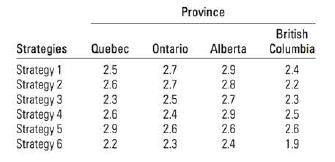b. A number of people from the selected provinces were randomized to the above strategies for lowering
Question:
b. A number of people from the selected provinces were randomized to the above strategies for lowering the salt intake. The data summarized in the following table were collected.

Each day, the average Canadian consumes excessive amounts of sodium-an average of 3,100 milligrams-more than double the adequate intake. There is no recommend- ed daily intake (RDI) for sodium... but there are adequate daily intake and tolerable upper intake levels. 3100 is more than double the 1200 to 1500 AI. The adequate daily intake for a healthy adult is 1,200 mg to 1,500 mg of sodium according to Health Canada and the U.S. National Academy of Sciences (Institute of Medicine) and a tolerable upper intake level is 2,300 mg. Statistics Canada estimates the average Canadian consumes more than 3,100 mg of sodium daily, making the goal of between 1,200 mg and 2,300 mg a significant reduction.
(i) What is the appropriate experimental design? (ii) What are the blocks? (iii) What are the treatments? (iv) Is blocking necessary in this problem? Justify your answer. Let a = 0.05. (v) Perform an analysis of variance treating the provinces as blocks. Use a = 0.05. (vi) Why is it necessary to treat the provinces as blocks? (vii) Use the p-value approach to determine whether there is a significant difference among the five strategies in reducing added unnecessary salt. What does this tell you about the appropriateness of the experimental design? viii) Use the p-value approach to determine whether there is a significant difference among the provinces' amount of salt intake at the 0.05 level of significance. (ix) Find a 95% confidence interval for the difference in means for Strategies 1 and 6. (x) Does it appear that the use of a randomized block design for this experiment was justified? Explain.
Step by Step Answer:

Introduction To Probability And Statistics
ISBN: 9780176509804
3rd Edition
Authors: William Mendenhall






